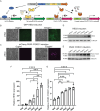New dual inducible cellular model to investigate temporal control of oncogenic cooperating genes
- PMID: 39237585
- PMCID: PMC11377716
- DOI: 10.1038/s41598-024-71227-3
New dual inducible cellular model to investigate temporal control of oncogenic cooperating genes
Abstract
The study of cooperating genes in cancer can lead to mechanistic understanding and identifying potential therapeutic targets. To facilitate these types of studies, we developed a new dual-inducible system utilizing the tetracycline- and cumate-inducible systems driving HES3 and the PAX3::FOXO1 fusion-oncogene, respectively, as cooperating genes from fusion-positive rhabdomyosarcoma. With this model, we can independently induce expression of either HES3 or PAX3::FOXO1, as well as simultaneously induce expression of both genes. This new model will allow us to further investigate the cooperation between HES3 and PAX3::FOXO1 including the temporal requirements for genetic cooperation. Functionally, we show that dual-induction of PAX3::FOXO1 and HES3 modifies sphere formation in a HEK293T-based system. More broadly, this lentiviral dual-inducible system can be adapted for any cooperating genes (overexpression or knockdown), allowing for independent, simultaneous, or temporally controlled gene expression.
Keywords: Cooperating genes; Cumate-inducible expression; Fusion-oncogene; Inducible expression; Temporal control; Tetracycline-inducible expression.
© 2024. The Author(s).
Conflict of interest statement
The authors declare no competing interests.
Figures




Update of
-
New Dual Inducible Cellular Model to Investigate Temporal Control of Oncogenic Cooperating Genes.bioRxiv [Preprint]. 2024 Feb 27:2024.02.23.581802. doi: 10.1101/2024.02.23.581802. bioRxiv. 2024. Update in: Sci Rep. 2024 Sep 5;14(1):20773. doi: 10.1038/s41598-024-71227-3. PMID: 38464002 Free PMC article. Updated. Preprint.
Similar articles
-
New Dual Inducible Cellular Model to Investigate Temporal Control of Oncogenic Cooperating Genes.bioRxiv [Preprint]. 2024 Feb 27:2024.02.23.581802. doi: 10.1101/2024.02.23.581802. bioRxiv. 2024. Update in: Sci Rep. 2024 Sep 5;14(1):20773. doi: 10.1038/s41598-024-71227-3. PMID: 38464002 Free PMC article. Updated. Preprint.
-
DNA methylation patterns are influenced by Pax3::Foxo1 expression and developmental lineage in rhabdomyosarcoma tumours forming in genetically engineered mouse models.J Pathol. 2025 Mar;265(3):316-329. doi: 10.1002/path.6386. Epub 2025 Jan 15. J Pathol. 2025. PMID: 39812007 Free PMC article.
-
Rhabdomyosarcoma fusion oncoprotein initially pioneers a neural signature in vivo.Cell Rep. 2025 Jul 22;44(7):115923. doi: 10.1016/j.celrep.2025.115923. Epub 2025 Jul 3. Cell Rep. 2025. PMID: 40614256 Free PMC article.
-
Prognostic value of PAX3/7-FOXO1 fusion status in alveolar rhabdomyosarcoma: Systematic review and meta-analysis.Crit Rev Oncol Hematol. 2015 Oct;96(1):46-53. doi: 10.1016/j.critrevonc.2015.04.012. Epub 2015 May 14. Crit Rev Oncol Hematol. 2015. PMID: 26008753
-
Systemic pharmacological treatments for chronic plaque psoriasis: a network meta-analysis.Cochrane Database Syst Rev. 2021 Apr 19;4(4):CD011535. doi: 10.1002/14651858.CD011535.pub4. Cochrane Database Syst Rev. 2021. Update in: Cochrane Database Syst Rev. 2022 May 23;5:CD011535. doi: 10.1002/14651858.CD011535.pub5. PMID: 33871055 Free PMC article. Updated.
Cited by
-
Fusion oncogenes in rhabdomyosarcoma: model systems, mechanisms of tumorigenesis, and therapeutic implications.Front Oncol. 2025 Jun 17;15:1570070. doi: 10.3389/fonc.2025.1570070. eCollection 2025. Front Oncol. 2025. PMID: 40599857 Free PMC article. Review.
References
MeSH terms
Substances
Grants and funding
LinkOut - more resources
Full Text Sources
Research Materials
Miscellaneous

